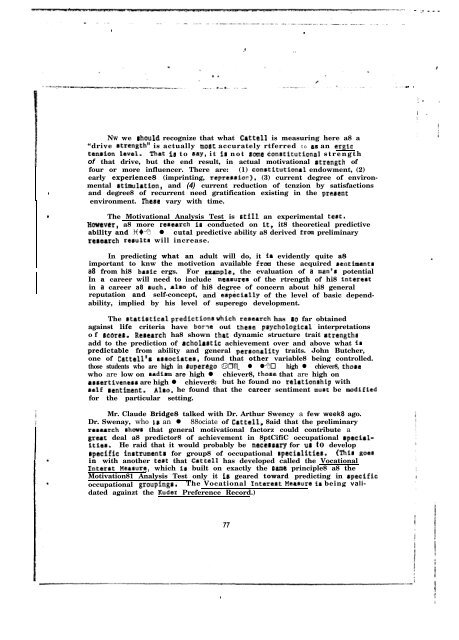Technical Report - International Military Testing Association
Technical Report - International Military Testing Association
Technical Report - International Military Testing Association
You also want an ePaper? Increase the reach of your titles
YUMPU automatically turns print PDFs into web optimized ePapers that Google loves.
.<br />
.<br />
. .<br />
,’ . .<br />
NW we rhould recognize that what Cattell is measuring here a8 a<br />
“drive rtrength” is actually mO8t accurately rtferred to ae an ergic<br />
ten8iOn 1eVel. That i8 to 8ay, it i8 not 8omc donstituticnnl strength<br />
of that drive, but the end result, in actual motivational 8trcngth of<br />
four or more influencer. There are: (1) con8titutional endowment, (2)<br />
early experience8 (imprinting, reprerzioc), (3) current degree of environmental<br />
8timulation, and (4) current reduction of tcnzion by satisfactions<br />
and degree8 of recurrent need gratification existing in the prerent<br />
environment. Theae vary with time.<br />
The Motivational Analysis Test is etill an experimental tert.<br />
Hwevtr, a8 more rerearch i8 conducted on it, it8 theoretical predictive<br />
ability and ��� � cutal predictive ability a8 derived fran preliminary<br />
reraarch rerulta will increase.<br />
In predicting what an adult will do, it 18 evidently quite a8<br />
important to knw the motivetion available frop these acquired rentimentr<br />
a8 from hi8 basic ergs. For urimple, the evaluation of a man’8 potential<br />
In a career will need to include mea8ure8 of the rtrength of hi8 intertrt<br />
in a career a8 8uch, 8180 of hi8 degree of concern about hi8 general<br />
reputation and self-concept, and ezp&ially of the level of basic dependability,<br />
implied by his level of superego development.<br />
The 8tati8ticalpredictionzwhich rezearch has 80 far obtained<br />
against life criteria have borne out these poychological interpretations<br />
of 8core8. Rerearch ha8 shown that dynamic structure trait rtrengthe<br />
add to the prediction of scholaetic achievement over and above what ir<br />
predictable from ability and general perronality traits. John Butcher,<br />
one of Cattell’s a88ociate8, found that other variable8 being controlled.<br />
those students who are high in ruperego ��� � ��� high � chiever8, there<br />
who are low on radi8m are high � chiever8, those that are high on<br />
arrertivene8s are high � chiever8: but he found no relationrhip with<br />
8elf rentimcnt. Aleo, he found that the career sentiment mU8t be modifiedI<br />
for the particular setting.<br />
Mr. Claude Bridge8 talked with Dr. Arthur Swency a few week8 ago.<br />
Dr. Swenay, who ie an � 88ociate of Cattell, 8aid that the preliminary<br />
reoearch rhwr that general motivational factorz could contribute a<br />
great deal a8 predictor8 of achievement in 8ptCifiC occupational rpecialities.<br />
He raid that it would probably be neceroary for u8 to develop<br />
rpecific inrtrumentr for group8 of occupational rpecialitier. (fii8 got8<br />
in with another te8t that Cattell has developed called the Vocational<br />
Interrt Heawre, which ir built on exactly the came principle8 a8 the<br />
Motivation81 Analysis Test only it iz geared toward predicting in 8pecifi.c<br />
occupational groupinga. The Vocational lnttrt8t Hearure ir being validated<br />
againzt the Kuder Preference Record.)<br />
.<br />
77<br />
-. -<br />
- :r ---<br />
i .









